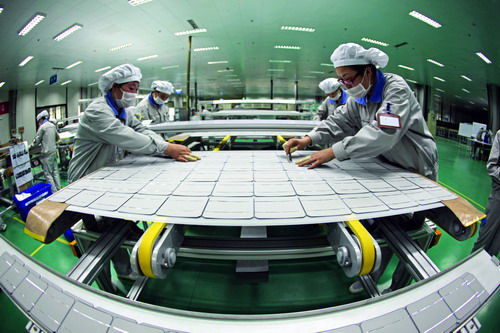Renewable energy riding high
By Meng Jing and Liu Yiyu (China Daily) Updated: 2012-02-25 10:29
|
 |
|
Employees at a solar cell production line in Lianyungang, Jiangsu province. China has become the world's largest maker of solar panels as it expands its push for renewable energy. [Photo/China Daily] |
China is putting greater emphasis on green energy as it tries to clean up industry and meet target for cuts in carbon emissions
BEIJING - If William Latta has his way, Beijing may soon have only clear blue skies. In his corner office on the 11th floor of a high-rise building near the capital's Sanlitun Village, Latta, the managing director of the US clean-coal company LP Amina LLC, said his company is working with coal-fired plants in China to reduce carbon emissions.
"See the smog out there? We can help with that," he said.
Latta is just one of the many next-generation Western technocrats and entrepreneurs who are helping China with its efforts to develop alternate energy resources and reduce carbon emissions. Over the past two years, China has already leapfrogged competitors from Denmark, Germany, Spain and the United States to become the world's largest maker of wind turbines and solar panels.
At the same time, the country is also taking steps to build more nuclear reactors and energy-efficient coal power plants.
The frantic pace at which China is expanding its push for renewable energy reflects its commitment to the reduction of carbon emissions as it strives for a more balanced growth model that is not reliant on costly imports of fossil fuels. The government has already announced plans to increase the share of non-fossil energy in total energy consumption to 11.4 percent by 2015 from 8.3 percent in 2010.
In December, the National Energy Administration, the top energy agency, said that power generated by clean-energy sources such as solar, wind, biomass and nuclear will account for energy equivalent to that produced by 480 million tons of standard coal between 2011 and 2015. That in itself would be a major achievement, considering that power generated by clean-energy sources was 300 million tons in the previous five years.
Despite hurdles such as overcapacity in China's wind- and solar-power equipment industry and the difficulty in connecting the power generated by wind to the grid, experts and analysts say that clean energy and clean technologies are strategic investments for China, not only for environmental reasons but also for energy security.
Frank Li, lead partner for the clean-tech industry at Deloitte Northern China, a member of Deloitte Touche Tohmatsu Ltd, said that he anticipates growth not only in his company's clean-tech related business in China but also in confidence in the country's general business climate for the clean-energy sector.
"People often ask me for advice, trying to see if wind and solar power are still worth investing in. It is true that there have been some problems in these sectors in China, such as overcapacity. But from a strategic point of view, none of these problems need be problems any more," Li said.
According to Li, China has the third-largest coal reserves in the world and is ranked 14 in terms of reserves of oil and natural gas. Coal contributes more than 70 percent of China's energy needs while oil and natural gas account for 21.6 percent. But despite the statistics, the deep fuel reserves are nothing when equated with China's population of 1.34 billion, the robust economy and growing energy needs. The country accounted for 20.3 percent of global energy consumption in 2010, and that figure is likely to rise dramatically.
"Statistics from BP's 2011 World Energy Review show, that based on China's reserves and its consumption in 2010, the coal reserves will be exhausted in 35 years, while oil will be used up in 9.9 years and natural gas in 29 years," he said.
Although improved exploration and exploitation techniques offer the prospect of finding more fossil fuels in China, there is no denying that they have a limited life span. For better energy security, it is not prudent for a country such as China to rely heavily on imported energy resources when its own reserves are declining.
In China's case, 55.8 percent of its oil requirement in 2010 came from imports, compared with 51 percent in 2008. More importantly, China needs to develop alternative energy resources, if it is to honor its global commitments on the reduction of carbon emissions, said experts.
Sean Gilbert, director of climate change and sustainability at global consultancy KPMG LLP, said that, in terms of reducing carbon emissions, one has to look into clean-energy sources, because improving energy efficiency alone is not good enough for the planet. Hence there is a big incentive for China to have ambitious installation goals for clean energy.
China has the globe's highest installed wind-power capacity and the highest number of nuclear power stations under construction. The country also produces the majority of the world's solar PV cells and is the biggest hydropower market.
"China has nearly one-fifth of the world population, so the total size of green-energy installations in China over time should reflect this and be a very large absolute figure. The current investments are welcome, but it is just the start of things to come," Gilbert said.
One of the biggest concerns expressed about clean energy is that its application leads to job losses. But experts say that not only does the sector hold the promise of more jobs, it will also create a cleaner, healthier future.
In November 2011, the China Council of International Cooperation on Environment and Development said that by 2015 China may spend an estimated 5.77 trillion yuan ($909 billion) to improve energy efficiency and protect the environment. At the same time, the phasing-out of high-polluting and energy-intensive industries could cost the country as many as 952,100 jobs and more than 100 billion yuan in economic output by 2015. However, in return the country could save 1.43 trillion yuan in energy expenses, boost GDP growth by 8.08 trillion yuan and create 10.58 million jobs.
According to estimates by Tsinghua University, investment in China's new-and clean-energy sectors will reach 5 trillion yuan in the coming 10 years. Such a huge market will provide several windows of opportunity for Western companies and multinationals.
Much of that optimism comes from the fact that Western companies still have the upper hand when it comes to advanced core technologies for clean energy, said Zhu Junsheng, president of the China Renewable Energy Industries Association.
"The competition is more intense than five years ago, but the pie of China's clean-energy sector is also getting bigger. There is still plenty of room for growth," said Zhu.
Shifting winds
The global trends for the wind power industry are not that encouraging considering the precarious financial situation in Europe and the weak US economy. Wind and other high-cost forms of energy production are virtually on the backburner, with some European nations even deciding to end subsidies for the sector.
But the market for wind turbines has been growing steadily in China, and that's why large European conglomerates such Siemens AG have such strong confidence in the Chinese market.
Siemens, a leading supplier of wind-power solutions, has teamed up with Shanghai Electric Group Co Ltd to form two joint ventures for wind power with the aim of strengthening the German company's footprint in China.
"China has a very attractive wind-power market, but the disadvantage of being in such an attractive market is the tough competition from both international and local players," said Kay Weber, CEO of Siemens Wind Power Asia-Pacific. "By forming joint ventures with a strong local partner, we can combine our strengths to be successful in China," he said.
Foreign producers of wind turbines have seen their market share in China drop dramatically to 30 percent from 70 percent over the past five years after an increasing number of Chinese companies entered the sector, according to a study by Roland Berger Strategy Consultants, one of the largest consultancies in Europe.
When Siemens entered the wind-power industry in 2004 by acquiring the Danish wind turbine producer Bonus Energy A/S, China was not a top priority. "To be honest, at that time, we wanted to focus more on easier markets, such as Europe and America. But you cannot be successful in the world if you don't succeed in China," said Weber.
China has since overtaken the United States and is now the largest market for wind power. Although China's newly installed wind-power capacity has slowed from an annual growth rate of 100 percent between 2006 and 2010, it is still the most promising market for global suppliers of wind power equipment.
The China Wind Energy Development Roadmap 2050, released by the Energy Research Institute of the National Development and Reform Commission in October 2011, shows that China's annual new-installed wind capacity will remain steady at 15 gigawatts per year until 2020, 20 gW per year from 2020 to 2030, and 30 gW per year for the decade to 2050.
"Experience shows that government targets are often exceeded in China. Wind-power prices are coming down and are cheaper than solar power. We believe that the newly installed wind-power capacity in China will reach at least 20 gW per year," said Watson Liu, vice-president for Greater China at Roland Berger.
But the tempting market also lures more competitors, and therefore overcapacity is inevitable. Liu said that China's demand for wind-power equipment was 20gW in 2010 whereas the production capacity by Chinese producers alone was 30 gW.
There has been high number of accidents caused by failures and malfunctions of turbines, including massive power outages and even some fatalities.
China's National Energy Administration undertook many initiatives in 2011, by moving toward a more mature industry with higher standards for safety and quality control, grid connection requirements and a centralized approval process for wind-farm projects, all of which are expected to open up more investment opportunities for Western companies.
"We anticipate milestone developments in the Chinese wind sector over the next three to five years. There's a greater focus on safety, quality control and mature industry standards. Such trends will help high-quality and sophisticated turbine manufacturers like us," said Jens Tommerup, president of Vestas China, part of Vestas Wind Systems A/S.
- Beijing to see a surge in supply and transactions of luxury property
- Tsinghua Unigroup sticks to Taiwan investment plan
- China stresses technical advantages, safety in bid for Malaysia-Singapore high-speed railway
- China's Shenzhen to invest $200m in western Indonesia
- Outbound M&As expected to continue leading global market
- SF eyes backdoor listing
- SAP to cash in on e-commerce boom
- 'Living legend' in fashion sales to nurture online brands

















